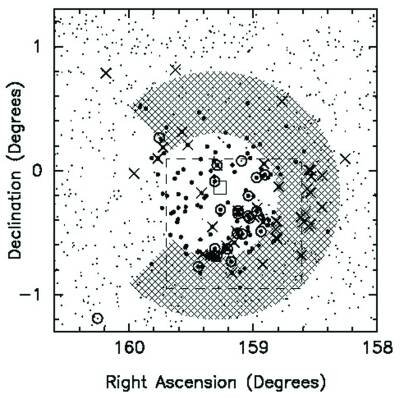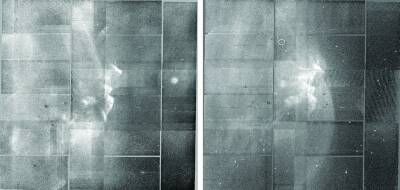The Largest Known Planetary Nebula on the Sky
Paul Hewett
* and Mike Irwin (IoA, Cambridge)
The enormous Sloan
Digital Sky Survey (SDSS) spectroscopic catalogue has many applications
but the discovery of Planetary Nebulae (PN) had not been recognised as among
the potential scientific returns. However, the INT recently played a key
role in the identification of a record breaking PN discovered serendipitously
from the SDSS.
The vast majority of PN in our own galaxy have been identified via wide-field
narrow-band Hα surveys of the type currently ongoing using the INT (
http://astro.ic.ac.uk/Research/Halpha/
North/) or through wide-field low-resolution slitless spectroscopic surveys,
with both techniques attempting to isolate objects showing very high equivalent
width emission lines that are characteristic of PN. The potential of the
relatively high-resolution, pointed spectra that make-up the SDSS spectroscopic
database involved a serendipitous observation during the course of a search
for high-redshift gravitational lenses. The idea behind the gravitational
lens search is to target luminous (massive) galaxies at intermediate redshifts,
0.2<z<0.6, which constitute the optimal line-of-sight for detecting
gravitationally lensed background sources (
Hewett
et al., 2000). The population of high-redshift star-forming galaxies,
many of which possess strong Lya emission, provide a high surface density
of readily detectable background sources. The first such object was discovered
by Warren et al. (
1996)
and the application of the SDSS survey for lenses at lower redshifts has
been demonstrated by Bolton et al. (
2004).
Examining the results of an automated search of the SDSS DR1 spectroscopic
database for emission lines from putative high-redshift sources, one particular
galaxy showed an unambiguous emission line detection with a somewhat weaker
feature to the blue. The emission line pair was immediately identifiable
as emission from [OIII] 4959, 5007. Not an entirely unexpected occurrence
but the unusual feature of the detection was that the wavelength of the detection
placed the emission at essentially zero radial velocity. Querying the output
of the emission line search for similar detections produced more spectra
showing a similar signature. All of the objects possessing [OIII] emission
occurred in an approximately circular region with a diameter of ~1.5°,
with not a single detection anywhere else on the sky. Investigation of SDSS
spectra of stars, quasars and even sky fibres revealed further detections,
all concentrated in the same region of sky.
A series of checks fairly rapidly eliminated the majority of instrumental
artifacts or transient phenomena as the cause of the emission. Discrete enquires
of the SDSS team produced the news that [OIII] emission had occasionally
been detected but this was due to auroral activity. However, the detection
of the [OIII] emission in two SDSS spectroscopic fields observed on different
nights and confirmation of the continued presence of [OIII] emission from
a spectrum obtained at the MMT Observatory ruled out an explanation due to
a transient phenomenon. Combining spectra beyond the boundaries of the region
where [OIII] emission was detected in individual produced clear detections
of [OIII] emission extending over a region more than 2° in diameter.
A smaller number of individual spectra also showed the presence of emission
from Hα and [NII] 6548, 6583. The spatial distribution of the individual
emission line detections revealed clear trends and composite spectra, made
up from objects contiguous on the sky, confirmed the trends and even allowed
the detection of [SII] 6718, 6732.
Figure 1 shows the
spatial distribution of line emission as derived from the SDSS spectra.

|
| Figure 1. Spatial distribution of spectra with
detectable [OIII] 4959, 5007 (dots), Hα (circles), and [NII] 6583 (crosses).
The hatched area indicates a region where composite spectra also show unambiguous
evidence of [OIII] 4959, 5007 emission. Positions of objects with SDSS spectra
for which no individual detections were obtained are also indicated. The
dashed outline shows the area included in the narrow-band images of Figure
2. The location of the white dwarf PG 1034+001 is marked by a box. [
JPEG | TIFF ]
|
Narrowband imaging of the central part of the region was undertaken during
a WFC survey run on the INT in 2003 May. The object is hard work, with integrations
of 1200 and 2700s in Hα and [OIII] 4959, 5007 respectively, necessary to
allow the detection of emission over the majority of the field. However, the
results were unambiguous, with excellent agreement between the surface brightness
distribution evident in the INT images (
Figure 2)
and the emission line detections from the SDSS spectra. A striking feature
of the images was the presence of a well-defined arc-like feature, perhaps
suggestive of some form of shock (
Hewett
et al., 2003).

|
| Figure 2. The left hand panel shows a mosaic of
6 INT WFC continuum–subtracted pointings in Hα+[NII] while the right panel
shows the equivalent for [OIII]. The images are approximately 0.8° on
a side with North to the top and East to the left. The location of the white
dwarf PG1034+001 is indicated by a circle in the [OIII] image. Emission with
complex structure is evident in the central regions of the images in both
passbands. A well–defined arc, or boundary, is visible at center–right in
the [OIII] image. [ JPEG | TIFF ] |
A wide range of possible explanations for the emission line region were
considered without success. Then, following the INT observations, a search
of the region using SIMBAD revealed the presence, close to the region with
the strongest [OIII] emission, of a very nearby, extremely hot DO white
dwarf (PG 1034+001). The location of the white dwarf clinched the identification
of the emission region as a PN. The diameter of more than 2° makes the
object the largest known PN on the sky and Rauch et al. (
2004)
have identified evidence for an ionised halo some 10° across.
PG 1034+001 does not yet possess a parallax distance but the spectroscopic
distance estimate of 155+58 pc (Werner et al., 1995) means the PN is certainly
the second closest known and a parallax distance could confirm the nebula
as the nearest PN to the Solar System. The unambiguous detection of a PN
associated with a non-DA white dwarf is also a first. Determination of a
reliable age for the PN will help constrain timescales associated with the
late stages of evolution of post-asymptotic giant branch stars and the origin
of helium-rich white dwarfs. The PN is certainly old, an estimate of the
expansion age and a kinematic age estimate, derived from extrapolating the
observed proper motion of PG 1034+001 back to the origin of the radius of
curvature of the arc feature, both suggest an age of ~100,000yr. The strongly
enhanced [NII] emission evident along the south western boundary of the
PN is also indicative of the interaction of an old PN with the surrounding
interstellar medium.
The strength of the [OIII] emission suggests that imaging of other hot
non-DA white dwarfs might be rewarding and we have begun such a programme
with the INT in collaboration with Matt Burleigh (Leicester). The first run
earlier this year suffered from poor conditions but preliminary results suggest
the detection of at least one new PN.
¤
References:
- Bolton, A., Burles, S., Schlegel, D., Eisenstein, D., Brinkmann,
J., 2004, AJ, 127, 1860. [ First citation
in text | ADS
]
- Hewett, P., Warren, S., Willis, J., Bland-Hawthorn, J., Lewis, G.,
2000, ASP Conf Ser, 195, 94 (astro-ph/9905316). [
First citation in text | ADS
]
- Hewett, P., Irwin, M., Skillman, E., Foltz, C., Willis, J., Warren,
S., Walton, N., 2003, ApJ, 599, L37. [ First citation in text | ADS
]
- Rauch, T., Kerber, F., Pauli, E.-M., 2004, A&A, 417,
647. [ First citation in text | ADS
]
- Warren, S., Hewett, P., Lewis, G., Moller, P., Iovino, A., Shaver,
P., 1996, MNRAS, 278, 139. [ First
citation in text | ADS
]
- Werner, K., Dreizler, S., Wolff, B., 1995, A&A, 298,
567. [ First citation in text | ADS
]
*Email contact: Paul Hewett (
phewett@ast.cam.ac.uk)




